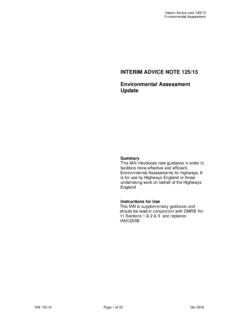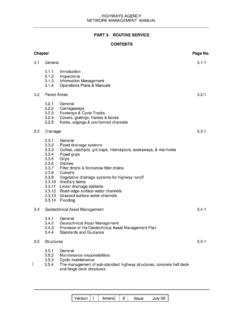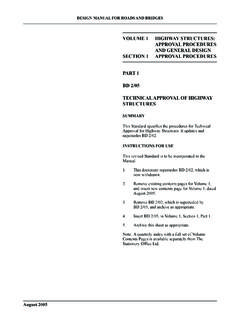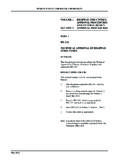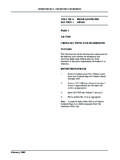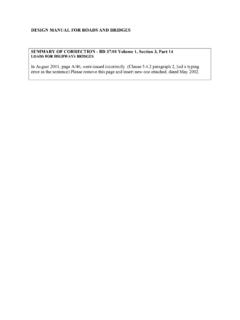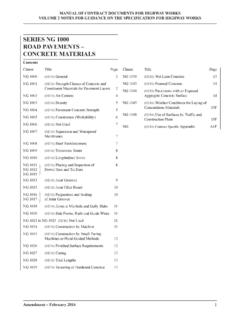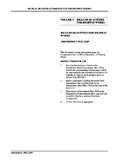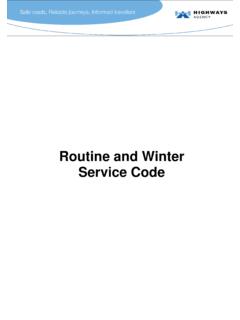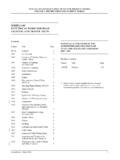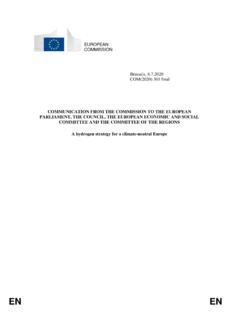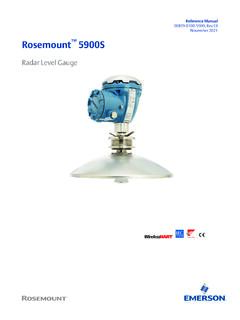Transcription of SERIES NG 400 ROAD RESTRAINT SYSTEMS (VEHICLE AND …
1 MANUAL OF CONTRACT DOCUMENTS FOR HIGHWAY WORKS. VOLUME 2 NOTES FOR GUIDANCE ON THE SPECIFICATION FOR HIGHWAY WORKS. SERIES NG 400. ROAD RESTRAINT SYSTEMS . (VEHICLE AND PEDESTRIAN). Contents Clause Title Page VEHICLE RESTRAINT SYSTEMS . General Requirements NG 401 (05/17) Vehicle RESTRAINT SYSTEMS General 2. NG 402 (05/17) Components for Maintenance and Repair of Legacy Vehicle RESTRAINT SYSTEMS 4. Safety Barriers, Terminals, Transitions, Removable Barrier Sections and Crash Cushions NG 403 (05/17) Installation of Safety Barriers (except vehicle parapets), Terminals, Transitions, Removable Barrier Sections and Crash Cushions Overall Requirements 5.
2 NG 404 (05/17) Site Testing for Contract Compliance 6. Vehicle Parapets NG 406 (05/17) General 6. NG 407 (05/17) Anchorages and Attachment SYSTEMS for Vehicle Parapets 7. NG 408 (05/17) Amendments and Additions to BS 6779 7. NG 409 (05/17) Inspection and Testing of Vehicle Parapet Posts 8. NG 410 (05/17) Site Tests on Anchorages in Drilled Holes for Vehicle Parapets 8. PEDESTRIAN RESTRAINT SYSTEMS . NG 411 (05/17) Pedestrian Parapets and Pedestrian Guardrails 9F. ANTI-GLARE SCREENS. NG 412 (05/17) Anti-Glare Screens 9F.
3 NG (05/17) Sample Contract Specific Appendices A1. Amendment May 2017 1. Volume 1 SERIES 400. Specification for Highway Works Road RESTRAINT SYSTEMS (Vehicle and Pedestrian). ROAD RESTRAINT SYSTEMS (VEHICLE AND. PEDESTRIAN). VEHICLE RESTRAINT SYSTEMS . General Requirements NG 401 (05/17) Vehicle RESTRAINT SYSTEMS General 1 (03/20) Safety barrier, vehicle parapet (excluding concrete vehicle parapet), terminal, transition and crash cushion SYSTEMS should conform to CD 377 (DMRB ), the various parts of BS EN 1317 and DD ENV 1317- 4:2002.
4 The introduction of these Standards ensures a consistent performance based standard is used in the testing and supply of Vehicle RESTRAINT SYSTEMS (VRS) throughout the European Economic Area and will thereby avoid barriers to trade'. 2 (05/17) BS EN 1317-5 is a harmonised standard covered by the Construction Products Regulation (EU. ) (CPR). Road RESTRAINT SYSTEMS that fall under the scope of this standard are thus required to be CE. marked and the manufacturer is required to draw up a declaration of performance.
5 BS EN 1317-5 uses the other parts of BS EN 1317 to establish the performance characteristics of SYSTEMS . 3 (05/17) DD ENV 1317-4 remains the reference for transitions, removable barrier sections and terminals in BS. EN 1317-5 and so it continues to be used. 4 (03/20) It is necessary for the compiler to specify VRS using performance class requirements and not by stipulating specific types of SYSTEMS . Contract specific Appendix 4/1 should be used by the compiler to detail the performance requirements using a schedule and other contract specific requirements.
6 The following should be included as required. (i) The type of RRS. (ii) The minimum Performance Class Requirements: Containment Level, Impact Severity Level [ISL], Working Width Class [W], Vehicle Intrusion Class [VI], Performance Level, Redirection Zone Class [Z], Permanent Lateral Displacement Zone Class [D], Performance Class [P], Permanent Lateral Displacement Zone [ ], Exit Box Class[Z]. (iii) other requirements including: the Length of Need (as defined in CD 377), the Setback (as defined in CD 127), the need for double or single sided VRS.
7 The minimum height of parapets (as defined in CD 377), requirements for pedestrian provision (is a vehicular or pedestrian/vehicular parapet required for example). the maximum height of the road RESTRAINT that allows the required visibility for road users for crash cushions whether they should be redirective or non-redirective. for crash cushions and terminals, whether they should be single sided or double sided, the required clearance to any highway feature that is vulnerable to residual loading, the need for mitigation measures for motorcyclists, Amendment March 2020 2.
8 Volume 1 SERIES 400. Specification for Highway Works Road RESTRAINT SYSTEMS (Vehicle and Pedestrian). measures to reduce the risk of injury to pedestrians, equestrians and other vulnerable users ( no sharp edges), plinth width for parapets. Where the Road RESTRAINT Risk Assessment Process (RRRAP) has been used for the design process the compiler will need to incorporate the outputs into contract specific Appendix 4/1 as appropriate. Where amendments to the format of contract specific Appendix 4/1 have been made in comparison to the RRRAP output the compiler will need to make adjustments as necessary.
9 CD 377 also requires the RRRAP outputs to be included with the designer's health and safety documentation required under the CDM regulations. Where it is proposed to attach a Road RESTRAINT System (RRS) partially or wholly to a structure any particular requirements or restrictions of the RRS with respect to the structure or conversely requirements or restrictions of the structure with respect to the RRS should be described. The RRS may be continuous over a structure or in front of the structure, or the RRS may be supported by an additional element such as an independent slab across a structure or form a connection with the elements of a structure.
10 These requirements may include, but not be limited to, the following: (i) Loads and their points of origin transmitted from the RRS to be resisted by the structure;. (ii) Limits of loads that may be resisted by the structure from the RRS and the points of application of those loads;. (iii) Maximum loads that may be resisted by any existing anchorage SYSTEMS ;. (iv) Geometric restrictions of either the RRS or the structure;. (v) Testing of any existing anchorage SYSTEMS '. 5 (05/17) The Contractor is required to submit details of the proposed vehicle RESTRAINT SYSTEMS to the Overseeing Organisation with the supporting information stated in Clause 401 demonstrating compliance with the specification.
